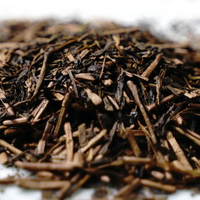Organic Hojicha from Shizuoka





Organic Hojicha from Shizuoka
Dry, woody notes for cosy evenings. The unmistakeable experience of fresh hojicha, calming and grounding for the soul.
Hojicha is produced by steaming and then roasting green tea leaves. The roast is light, so as to preserve the smooth, mellow taste and the beneficial nutrients contained in the leaves.
In Japan hojicha is often given to babies and the sick due to its soothing qualities, low caffeine content and health benefits. We love to have one as an after-meal digestif or comforting late-night brew.
Hojicha is often made with lower quality sencha leaves, however this premium hojicha consists of only the highest grade leaves from the first harvest. The result is a nuanced palate of flavours and a cleansing finish.
Shizuoka, Honshu (Japan)
Roasted hazelnut, maple sap, caramel.
Smooth lingering aroma, dry woody notes with roasted nutty undertones and subtle complexities from the local terroir.
For two cups:
7-8g
200ml / 90-100 °C
15-30s
This tea can be brewed up to 3 times.
Introducing
Hojicha Roasted Green Tea
Hojicha is a roasted green tea with a lovely dry, woody taste that is both soothing and grounding. Due to the roasting process the leaves and liquor are not green, but of a beautiful reddy-brown hue. Hojicha is great for any time of day, however with its low caffeine content it's perfect to be enjoyed in the evenings. As a general comparison, an average cup of coffee contains approximately 90mg of caffeine, sencha 30mg, whilst a cup of hojicha only 7.7mg.
Most hojichas are composed of late-harvest leaves and stems of sencha, a lower quality tea known as 'bancha'. The tea itself became highly popularised throughout the 20th century due to the fact that farmers could greatly minimise organic waste and subsequently maximise utility from sencha production.
The hojicha that we stock at Yamoku however is of a premium quality, using the leaves from the very first harvest. This offers a tantalising depth of flavour and quality that is missed in lower quality hojicha leaves.
Roasting process
Tea roasting originated in China during the 17th century, making its way to Japan shortly after. The number of tea masters trained in the traditional roasting methods today is scarce, making true artisanal roasted tea a rarity.
Another type of tea produced using these special methods is kamairicha, where the artform is used to draw out infinitely subtle characteristics from the tea leaves.
Like other Japanese green teas, hojicha goes through a steaming process after being picked. Once the leaves are steamed, rolled and dried, another stage is added whereby the leaves and stems are expertly roasted in a porcelain pot over charcoal to draw out the subtle qualities of the tea.
Tea can also be pan fired or roasted in iron vessels, producing a toasted nutty flavour in the hojicha, with smoky undertones that some compare with popular Chinese teas such as Oolong.
Artisanal flavours for the soul
The result of this nuanced roasting process is hojicha, offering a wonderful nutty fragrance, and a smooth yet earthy experience lingering on the palate.
Hojicha is a regular favourite across Japan - enjoyed throughout the day by the tea pickers, as well as children and the elderly. Its soothing properties are great after a meal, and it also makes a formidible beverage during the hot summer months as a cold brew!





